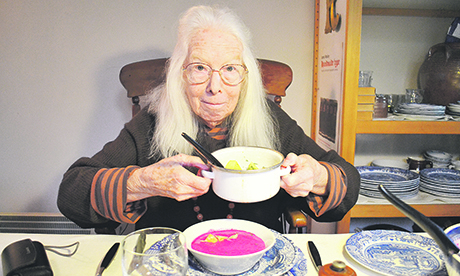Polish grub puts Eastern European nation in pole position in food stakes

Spud anyone? Gillian Riley prepares boiled potatoes as a side to the Polish dish Chlodnik. Photograph: Annalies Winny
The number of Polish people living and working in Hackney can be measured by the food stores that have opened in the past decade.
We have sampled the delights of Italian salumeria, enjoyed French pâtés in Broadwick Market, eaten Turkish kebabs all over the place, and so should not let the language barrier deter us from devouring the hidden treasures of these new Polish stores; a simple meal of sliced sausages with good Polish bread, herrings in a cream sauce, some nice pickles and a slug of Wodka is the entry point to a world of hidden gastronomic delights.
The thousand dollar question, though, remains unanswered: Why are there no Polish restaurants in Hackney? And why are there precious few in the whole of London?
When I put this question to a charming young woman in the Polsmak deli in Balls Pond Road, she smiled shyly, and when I suggested that it was because Polish home cooking was so very good, she laughed out loud. This hearty but subtle food must be Hackney’s best-kept gastronomic secret. The hidden cuisine of a pleasure-loving nation with a complex past and future could perhaps only flourish at home, where the rhythms of drinking and eating are a marker of solidarity and affection, impossible to achieve in the constraints of a restaurant’s agenda and time scale.
That said, kind help is forthcoming and good advice comes willingly in Hackney’s Polish food stores.
Throughout its history Polish food has been a sort of fusion of peasant and aristocratic cuisines.
When the young Italian princess Bona Sforza, raised in the mellow climate of Bari in the south of Italy, came to Poland as the second wife of King Sigismund I in 1518, she brought her own cooks and ingredients and the fashionable Italian passion for salads and exotic vegetables. So although the local fruit and veg had been used imaginatively for centuries, new delicacies were added to the kitchen gardeners’ repertoire – spinach, fresh green peas, leeks, artichokes and asparagus. But Bona was not slumming, she joined a politically powerful nation with centuries of civilized living behind it, and used her considerable ambition and political skills to enhance Polish diplomacy. Sadly her retirement to Bari in 1556 was cut short by suspected poisoning by one of her retainers.
Much of the fresh fruit and vegetables so important to Polish cuisine can be found in the shops of other nations, but the use made of them is uniquely Polish, and the light fresh pickles and substantial vegetable stews are special.
It would be a mistake to think that the rest of Polish cuisine is all cabbage and sausage and mushrooms and buckwheat; my exploration of delis and food shops reveals unexpected and delicious items. Cured and cooked meat products come in a huge variety, from little smoked pork sausages for casual munching, to large ones, made from pork, beef, or chicken, to cooked or cured bacon, lightly smoked and unctuous and chewy, all enjoyed cold and sliced, or hot, cooked in various ways.
But the cabbage cannot be ignored; the British way used to be so horrible that we might fail to appreciate the versatility of this resilient vegetable in all its different varieties. Polish cooking exploits the possibilities with brilliance.
Recipe: Chlodnik
This is a Lithuanian version of a classic Polish dish. There are many possible variations, but whatever you do, you end up with an easy and remarkably delicious dish, ideal on hot summer days, as a meal in itself. The glaring bright pink of the beetroot juice is startling.
Two uncooked beetroot, scrubbed or peeled
Water to cover
One litre buttermilk
One carton of crème fraîche
Four eggs, hard boiled, shelled and quartered
Small Polish pickled gherkins, chopped, and some of their liquid
Chopped garlic chives
Chopped dill
Chopped parsley
One Turkish cucumber, peeled and diced
One bunch of pink radishes, thinly sliced
One carton of crayfish tails
500 g potatoes, peeled and boiled, nice and hot
Cook the beetroot until just soft, then blast in a liquidizer, with some of the cooking liquid. Pour the beetroot into a bowl and stir in the buttermilk and crème fraîche. Taste.
You want to aim at balancing the earthy sweetness of the beetroot with the tart fresh acidity of the buttermilk, and the richness of the cream, together with some of the liquid from the pickled gherkins.
Add salt and some of the beetroot cooking water if needed.
Chill for several hours. Just before serving sprinkle in the cucumber, radish, crayfish tails and herbs, and the hardboiled egg.
Serve with the hot potatoes on the side. They add bulk and a surprising blast of flavour, as the heat releases the aromas.
Gillian Riley is a food writer and the author of The Oxford Companion to Italian Food
Related:
Food historian Gillian Riley shows how to dine like a 15th century gastronome
Time is nigh for Gothic feasting, says food historian Gillian Riley
